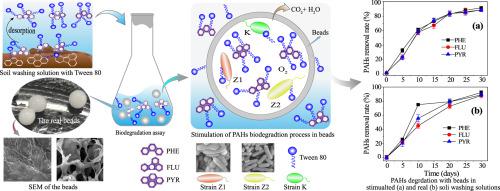Journal of Environmental Management ( IF 8.0 ) Pub Date : 2021-07-29 , DOI: 10.1016/j.jenvman.2021.113415 Yan Wen 1 , Xiaoyi Xu 1 , Bin Wang 2 , Zhimin He 1 , Jing Bai 3 , Xiaobin Chen 1 , Jiahao Cui 1 , Xiaofang Xu 3

|
In this study, the biodegradation of polycyclic aromatic hydrocarbons (PAHs) in soil washing solution containing Tween 80 was conducted using native mixed bacteria (Pseudomonas sp. Z1, Sphingobacterium sp. Z2, and Klebsiella sp. K) embedded in polyvinyl alcohol-sodium alginate-nano alumina (PVA-SA-ALNPs) gel beads. The optimal dosage of immobilized beads and embedded biomass for the biodegradation of phenanthrene (PHE), fluoranthene (FLU), and pyrene (PYR) were 10 % (v/v) and 20 % (v/v), respectively. SEM analysis showed that the porous structure of the immobilized beads was a cross-linked network with abundant pores that provided many potential adhesion sites for microorganisms. The beads with the immobilized mixed bacteria maintained a high activity during batch experiments and could even be reused for 3 cycles (90 d). Compared with the beads containing individual immobilized strain, the immobilized mixed bacteria showed a more efficient biodegradation of PHE (91.67 %), FLU (88.6 %), and PYR (88.5 %) in synthetic soil washing effluent within 30 d. The first-order kinetic model suitably described the degradation process of the three target PAHs. By adding Tween 80 to the synthetic eluent, the degradation of PHE, FLU, and PYR increased by 16.39 %, 22.25 %, and 21.29 %, respectively, indicating that Tween 80 promoted PAHs biodegradation, even though it was also rapidly degraded during the reaction cycle. These findings suggest that the developed mixed bacteria embedded in PVA-SA-ALNPs gel beads has great potential for PAHs remediation.
中文翻译:

嵌入聚乙烯醇-海藻酸钠-纳米氧化铝凝胶珠的天然混合菌对土壤洗涤废水中多环芳烃的生物降解
在这项研究中,在含有吐温80洗涤土壤溶液的多环芳香烃(PAHs)的生物降解已使用本机混合菌(进行假单胞菌属。 Z1,鞘氨醇杆菌属Z2,和克雷伯氏菌sp. K) 嵌入聚乙烯醇-海藻酸钠-纳米氧化铝 (PVA-SA-ALNPs) 凝胶珠中。用于生物降解菲 (PHE)、荧蒽 (FLU) 和芘 (PYR) 的固定珠粒和嵌入生物质的最佳剂量分别为 10% (v/v) 和 20% (v/v)。SEM 分析表明,固定珠的多孔结构是一个交联网络,具有丰富的孔隙,为微生物提供了许多潜在的粘附位点。带有固定化混合细菌的珠子在批量实验中保持高活性,甚至可以重复使用 3 个循环(90 天)。与含有单个固定化菌株的珠子相比,固定化混合细菌在 30 d 内对合成土壤洗涤废水中的 PHE (91.67 %)、FLU (88.6 %) 和 PYR (88.5 %) 显示出更有效的生物降解。一级动力学模型恰当地描述了三种目标多环芳烃的降解过程。通过在合成淋洗液中加入 Tween 80,PHE、FLU 和 PYR 的降解率分别增加了 16.39%、22.25% 和 21.29%,表明 Tween 80 促进了 PAHs 的生物降解,尽管它在反应过程中也被迅速降解循环。这些发现表明,嵌入在 PVA-SA-ALNPs 凝胶珠中的混合细菌具有巨大的 PAHs 修复潜力。











































 京公网安备 11010802027423号
京公网安备 11010802027423号